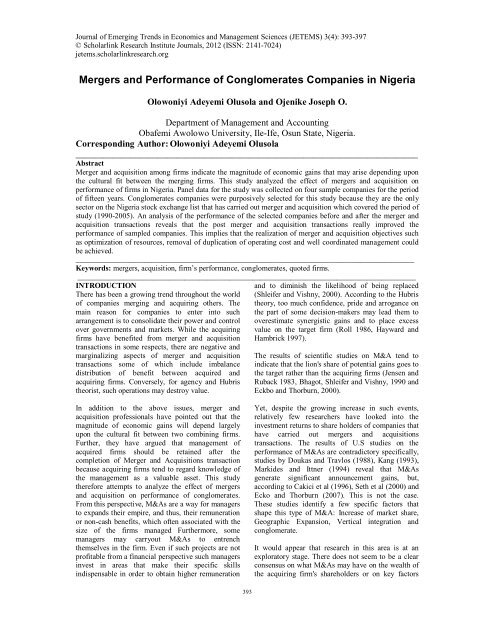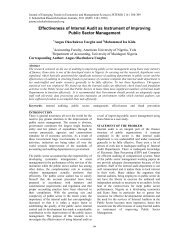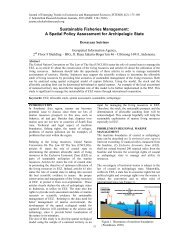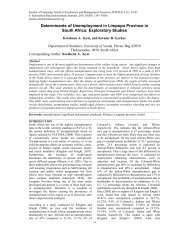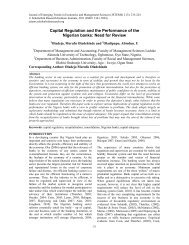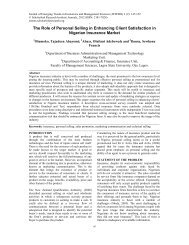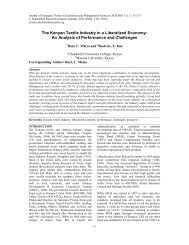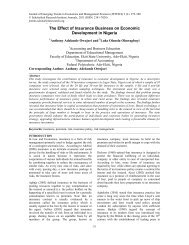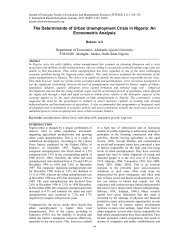Mergers and Performance of Conglomerates Companies in Nigeria
Mergers and Performance of Conglomerates Companies in Nigeria
Mergers and Performance of Conglomerates Companies in Nigeria
You also want an ePaper? Increase the reach of your titles
YUMPU automatically turns print PDFs into web optimized ePapers that Google loves.
Journal <strong>of</strong> Emerg<strong>in</strong>g Trends <strong>in</strong> Economics <strong>and</strong> Management Sciences (JETEMS) 3(4): 393-397<br />
© Scholarl<strong>in</strong>k Research Institute Journals, 2012 (ISSN: 2141-7024)<br />
Journal jetems.scholarl<strong>in</strong>kresearch.org<br />
<strong>of</strong> Emerg<strong>in</strong>g Trends Economics <strong>and</strong> Management Sciences (JETEMS) 3(4):393-397 (ISSN:2141-7024)<br />
<strong>Mergers</strong> <strong>and</strong> <strong>Performance</strong> <strong>of</strong> <strong>Conglomerates</strong> <strong>Companies</strong> <strong>in</strong> <strong>Nigeria</strong><br />
Olowoniyi Adeyemi Olusola <strong>and</strong> Ojenike Joseph O.<br />
Department <strong>of</strong> Management <strong>and</strong> Account<strong>in</strong>g<br />
Obafemi Awolowo University, Ile-Ife, Osun State, <strong>Nigeria</strong>.<br />
Correspond<strong>in</strong>g Author: Olowoniyi Adeyemi Olusola<br />
___________________________________________________________________________<br />
Abstract<br />
Merger <strong>and</strong> acquisition among firms <strong>in</strong>dicate the magnitude <strong>of</strong> economic ga<strong>in</strong>s that may arise depend<strong>in</strong>g upon<br />
the cultural fit between the merg<strong>in</strong>g firms. This study analyzed the effect <strong>of</strong> mergers <strong>and</strong> acquisition on<br />
performance <strong>of</strong> firms <strong>in</strong> <strong>Nigeria</strong>. Panel data for the study was collected on four sample companies for the period<br />
<strong>of</strong> fifteen years. <strong>Conglomerates</strong> companies were purposively selected for this study because they are the only<br />
sector on the <strong>Nigeria</strong> stock exchange list that has carried out merger <strong>and</strong> acquisition which covered the period <strong>of</strong><br />
study (1990-2005). An analysis <strong>of</strong> the performance <strong>of</strong> the selected companies before <strong>and</strong> after the merger <strong>and</strong><br />
acquisition transactions reveals that the post merger <strong>and</strong> acquisition transactions really improved the<br />
performance <strong>of</strong> sampled companies. This implies that the realization <strong>of</strong> merger <strong>and</strong> acquisition objectives such<br />
as optimization <strong>of</strong> resources, removal <strong>of</strong> duplication <strong>of</strong> operat<strong>in</strong>g cost <strong>and</strong> well coord<strong>in</strong>ated management could<br />
be achieved.<br />
_________________________________________________________________________________________<br />
Keywords: mergers, acquisition, firm’s performance, conglomerates, quoted firms.<br />
_________________________________________________________________________________________<br />
INTRODUCTION<br />
There has been a grow<strong>in</strong>g trend throughout the world<br />
<strong>of</strong> companies merg<strong>in</strong>g <strong>and</strong> acquir<strong>in</strong>g others. The<br />
ma<strong>in</strong> reason for companies to enter <strong>in</strong>to such<br />
arrangement is to consolidate their power <strong>and</strong> control<br />
over governments <strong>and</strong> markets. While the acquir<strong>in</strong>g<br />
firms have benefited from merger <strong>and</strong> acquisition<br />
transactions <strong>in</strong> some respects, there are negative <strong>and</strong><br />
marg<strong>in</strong>aliz<strong>in</strong>g aspects <strong>of</strong> merger <strong>and</strong> acquisition<br />
transactions some <strong>of</strong> which <strong>in</strong>clude imbalance<br />
distribution <strong>of</strong> benefit between acquired <strong>and</strong><br />
acquir<strong>in</strong>g firms. Conversely, for agency <strong>and</strong> Hubris<br />
theorist, such operations may destroy value.<br />
<strong>and</strong> to dim<strong>in</strong>ish the likelihood <strong>of</strong> be<strong>in</strong>g replaced<br />
(Shleifer <strong>and</strong> Vishny, 2000). Accord<strong>in</strong>g to the Hubris<br />
theory, too much confidence, pride <strong>and</strong> arrogance on<br />
the part <strong>of</strong> some decision-makers may lead them to<br />
overestimate synergistic ga<strong>in</strong>s <strong>and</strong> to place excess<br />
value on the target firm (Roll 1986, Hayward <strong>and</strong><br />
Hambrick 1997).<br />
The results <strong>of</strong> scientific studies on M&A tend to<br />
<strong>in</strong>dicate that the lion's share <strong>of</strong> potential ga<strong>in</strong>s goes to<br />
the target rather than the acquir<strong>in</strong>g firms (Jensen <strong>and</strong><br />
Ruback 1983, Bhagot, Shleifer <strong>and</strong> Vishny, 1990 <strong>and</strong><br />
Eckbo <strong>and</strong> Thorburn, 2000).<br />
In addition to the above issues, merger <strong>and</strong><br />
acquisition pr<strong>of</strong>essionals have po<strong>in</strong>ted out that the<br />
magnitude <strong>of</strong> economic ga<strong>in</strong>s will depend largely<br />
upon the cultural fit between two comb<strong>in</strong><strong>in</strong>g firms.<br />
Further, they have argued that management <strong>of</strong><br />
acquired firms should be reta<strong>in</strong>ed after the<br />
completion <strong>of</strong> Merger <strong>and</strong> Acquisitions transaction<br />
because acquir<strong>in</strong>g firms tend to regard knowledge <strong>of</strong><br />
the management as a valuable asset. This study<br />
therefore attempts to analyze the effect <strong>of</strong> mergers<br />
<strong>and</strong> acquisition on performance <strong>of</strong> conglomerates.<br />
From this perspective, M&As are a way for managers<br />
to exp<strong>and</strong>s their empire, <strong>and</strong> thus, their remuneration<br />
or non-cash benefits, which <strong>of</strong>ten associated with the<br />
size <strong>of</strong> the firms managed Furthermore, some<br />
managers may carryout M&As to entrench<br />
themselves <strong>in</strong> the firm. Even if such projects are not<br />
pr<strong>of</strong>itable from a f<strong>in</strong>ancial perspective such managers<br />
<strong>in</strong>vest <strong>in</strong> areas that make their specific skills<br />
<strong>in</strong>dispensable <strong>in</strong> order to obta<strong>in</strong> higher remuneration<br />
Yet, despite the grow<strong>in</strong>g <strong>in</strong>crease <strong>in</strong> such events,<br />
relatively few researchers have looked <strong>in</strong>to the<br />
<strong>in</strong>vestment returns to share holders <strong>of</strong> companies that<br />
have carried out mergers <strong>and</strong> acquisitions<br />
transactions. The results <strong>of</strong> U.S studies on the<br />
performance <strong>of</strong> M&As are contradictory specifically,<br />
studies by Doukas <strong>and</strong> Travlos (1988), Kang (1993),<br />
Markides <strong>and</strong> Ittner (1994) reveal that M&As<br />
generate significant announcement ga<strong>in</strong>s, but,<br />
accord<strong>in</strong>g to Cakici et al (1996), Seth et al (2000) <strong>and</strong><br />
Ecko <strong>and</strong> Thorburn (2007). This is not the case.<br />
These studies identify a few specific factors that<br />
shape this type <strong>of</strong> M&A: Increase <strong>of</strong> market share,<br />
Geographic Expansion, Vertical <strong>in</strong>tegration <strong>and</strong><br />
conglomerate.<br />
It would appear that research <strong>in</strong> this area is at an<br />
exploratory stage. There does not seem to be a clear<br />
consensus on what M&As may have on the wealth <strong>of</strong><br />
the acquir<strong>in</strong>g firm's shareholders or on key factors<br />
393
Journal <strong>of</strong> Emerg<strong>in</strong>g Trends <strong>in</strong> Economics <strong>and</strong> Management Sciences (JETEMS) 3(4):393-397 (ISSN:2141-7024)<br />
determ<strong>in</strong><strong>in</strong>g the performance <strong>of</strong> such operations.<br />
Exist<strong>in</strong>g studies only cover the short-term impacts<br />
which this study notes as is shortcom<strong>in</strong>g. M&As are<br />
very complex operations <strong>and</strong> their impact on<br />
acquir<strong>in</strong>g firms will depend on a comb<strong>in</strong>ation <strong>of</strong><br />
factors which are very difficult to assess at the time<br />
<strong>of</strong> announcement this context, f<strong>in</strong>ancial markets are<br />
only partially efficient.<br />
Studies by Micheli <strong>and</strong> Stafford (2000) on evaluation<br />
<strong>of</strong> M&As are aimed at evaluat<strong>in</strong>g the extent to which<br />
the short-term losses or ga<strong>in</strong>s reported by f<strong>in</strong>ancial<br />
markets when the M&A is announced are later<br />
ma<strong>in</strong>ta<strong>in</strong>ed. In theory, the market value <strong>of</strong> these firms<br />
should not be seen to fluctuate abnormally<br />
consider<strong>in</strong>g their respective risk or compared to<br />
similar firms that have not carried out an M&A.<br />
Several studies by Loderer <strong>and</strong> Mart<strong>in</strong> (1992) have<br />
exam<strong>in</strong>ed on evaluation <strong>of</strong> acquir<strong>in</strong>g firms engaged<br />
<strong>in</strong> M&As. The returns are estimated with stock<br />
market data cover<strong>in</strong>g the three to five years after the<br />
M&A's announcement. The results obta<strong>in</strong>ed are<br />
contradictory. They tend to demonstrate that<br />
efficiency <strong>and</strong> synergistic ga<strong>in</strong>s are not always full<br />
realized. Agrawal, Jaffe <strong>and</strong> M<strong>and</strong>elker (1992)<br />
suggest that acquir<strong>in</strong>g firms susta<strong>in</strong> losses, while<br />
Loderer <strong>and</strong> Mart<strong>in</strong> (1992), Lough ran <strong>and</strong> Vijh<br />
(1997) <strong>and</strong> Mitchell <strong>and</strong> Stafford (2000) obta<strong>in</strong><br />
virtually no abnormal returns. Furthermore, Franks,<br />
Harris <strong>and</strong> Titman (1991) <strong>and</strong> Rau <strong>and</strong> Vermaelen<br />
(1998) obta<strong>in</strong> different results depend<strong>in</strong>g on the<br />
methodologies used or the subsets considered.<br />
In <strong>Nigeria</strong>, many quoted firms have implemented<br />
M&A transactions or plan to engage <strong>in</strong> such<br />
transactions because this method is known to be<br />
cheaper <strong>and</strong> quicker than others such as <strong>in</strong>ternal<br />
development or strategic alliance for achiev<strong>in</strong>g<br />
growth. However, empirical research f<strong>in</strong>d<strong>in</strong>gs drawn<br />
from other fields other than quoted firms’ research do<br />
not provide solid guidance whether quoted firms<br />
should seek M&A transaction that is some studies<br />
have reported that M&A transactions weakened the<br />
position <strong>of</strong> a firm <strong>in</strong> the competitive market, while<br />
others have <strong>in</strong>dicated that M&A generated significant<br />
economic returns (Olowe, 1998)<br />
Further, <strong>in</strong> a more narrow perspective, no consensus<br />
has been reached regard<strong>in</strong>g whether firms should<br />
acquire related or unrelated bus<strong>in</strong>esses. The<br />
transactions <strong>of</strong> mergers <strong>and</strong> acquisitions <strong>in</strong> the quoted<br />
firms, as <strong>in</strong> other firms, <strong>in</strong>creased dramatically dur<strong>in</strong>g<br />
the 1990s till present. However, little research has<br />
been reported on the phenomenon <strong>of</strong> M&A<br />
transactions given the tremendous number <strong>and</strong> the<br />
value <strong>of</strong> such transactions. The research that does<br />
exist is extremely prescriptive or theoretical rather<br />
than descriptive. It is hope that this study will fill the<br />
gap <strong>and</strong> provide a systematic research that addresses<br />
the prevail<strong>in</strong>g phenomenon <strong>of</strong> M&A transactions <strong>in</strong><br />
<strong>Nigeria</strong>.<br />
Contemporary bus<strong>in</strong>ess organization seek to grow for<br />
bus<strong>in</strong>ess survival <strong>and</strong> such an assertion can be<br />
supported by Freier's (1990) empirical observation<br />
that "over the past twenty (20) years, the m<strong>in</strong>imum<br />
company size required to compete successfully <strong>in</strong><br />
most <strong>in</strong>dustry segments has been steadily <strong>in</strong>creas<strong>in</strong>g".<br />
Under the premise that growth is a vital element for<br />
bus<strong>in</strong>ess survival, a firm can grow <strong>and</strong> develop core<br />
competences either <strong>in</strong>ternally by <strong>in</strong>vest<strong>in</strong>g <strong>in</strong> <strong>and</strong><br />
nurtur<strong>in</strong>g with<strong>in</strong>-firm resources or externally by<br />
acquir<strong>in</strong>g another firm.<br />
Corporate organizations need to exp<strong>and</strong> <strong>in</strong> today's<br />
<strong>in</strong>creas<strong>in</strong>gly competitive <strong>and</strong> <strong>in</strong>ternational bus<strong>in</strong>ess<br />
environment so as to achieve economies <strong>of</strong> scale <strong>in</strong><br />
production, promotion <strong>and</strong> distribution. <strong>Mergers</strong> <strong>and</strong><br />
acquisition is no doubt one way <strong>in</strong> which to obta<strong>in</strong><br />
such drastic expansion or growth. In his book- "The<br />
corporate mergers", Albert <strong>and</strong> Joel, (1986) "One <strong>of</strong><br />
the key stones <strong>of</strong> a free enterprises <strong>and</strong> prices<br />
determ<strong>in</strong>ed economy (i.e. capitalism) is the strategy<br />
for entry". Every corporate entity <strong>in</strong> such an economy<br />
is faced with a problem <strong>of</strong> growth whether <strong>in</strong> output<br />
or pr<strong>of</strong>itability. In today's global bus<strong>in</strong>ess<br />
environment companies may have to grow to survive<br />
<strong>and</strong> one <strong>of</strong> the best ways to grow is by merg<strong>in</strong>g with<br />
another company or acquir<strong>in</strong>g other companies.<br />
Growth may be achieved through <strong>in</strong>ternal or external<br />
entry <strong>in</strong>to a new <strong>in</strong>dustry or market. While <strong>in</strong>ternal<br />
entry <strong>in</strong>volves -<strong>in</strong>creas<strong>in</strong>g unit sales consistently <strong>and</strong><br />
develop<strong>in</strong>g new products through research <strong>and</strong><br />
development; External entry <strong>in</strong>cludes - <strong>Mergers</strong> <strong>and</strong><br />
Acquisitions <strong>and</strong> strategic alliance.<br />
A merger occurs when one firm assumes all the<br />
assets <strong>and</strong> all the liabilities <strong>of</strong> another firm. The<br />
acquir<strong>in</strong>g firm reta<strong>in</strong>s it's identify, while the acquired<br />
firm ceases to exist. A majority vote <strong>of</strong> shareholders<br />
is generally required to approve a merger. A merger<br />
is just one types <strong>of</strong> acquisition. One company can<br />
acquire another company <strong>in</strong> several other ways,<br />
<strong>in</strong>clud<strong>in</strong>g purchas<strong>in</strong>g some or all <strong>of</strong> the company's<br />
assets or buy<strong>in</strong>g up its outst<strong>and</strong><strong>in</strong>g shares <strong>of</strong> "stock.<br />
In general, mergers <strong>and</strong> acquisitions are performed <strong>in</strong><br />
the hopes <strong>of</strong> realiz<strong>in</strong>g an economic ga<strong>in</strong>. For such a<br />
transaction to be justified, the two firms <strong>in</strong>volved<br />
must be worth more together than they were apart.<br />
Some <strong>of</strong> the potential advantages <strong>of</strong> mergers <strong>and</strong><br />
acquisition <strong>in</strong>clude achiev<strong>in</strong>g economics <strong>of</strong> scale,<br />
comb<strong>in</strong><strong>in</strong>g complementary resources, garner<strong>in</strong>g tax<br />
advantages <strong>and</strong> elim<strong>in</strong>at<strong>in</strong>g <strong>in</strong>efficiencies. Other<br />
reasons for consider<strong>in</strong>g growth through mergers <strong>and</strong><br />
acquisitions <strong>in</strong>clude obta<strong>in</strong><strong>in</strong>g proprietary rights to<br />
products or services, <strong>in</strong>creas<strong>in</strong>g market power by<br />
purchas<strong>in</strong>g competitors, shor<strong>in</strong>g up weaknesses <strong>in</strong><br />
key bus<strong>in</strong>ess areas, penetrat<strong>in</strong>g new geographic<br />
394
Journal <strong>of</strong> Emerg<strong>in</strong>g Trends <strong>in</strong> Economics <strong>and</strong> Management Sciences (JETEMS) 3(4):393-397 (ISSN:2141-7024)<br />
regions or provid<strong>in</strong>g managers with new<br />
opportunities for career growth <strong>and</strong> advancement.<br />
When a small bus<strong>in</strong>ess owner chooses to merge with<br />
or sells out to another company, it is sometimes<br />
called "harvest<strong>in</strong>g", the small bus<strong>in</strong>ess. In this<br />
situation, the transaction is <strong>in</strong>tended to release the<br />
value locked up <strong>in</strong> the small bus<strong>in</strong>ess for the benefit<br />
<strong>of</strong> its owner <strong>and</strong> <strong>in</strong>vestors. The impetus for a small<br />
bus<strong>in</strong>ess owner to pursue a sale or merger may<br />
<strong>in</strong>volve a need to diversify his or her <strong>in</strong>vestment, an<br />
<strong>in</strong>ability to f<strong>in</strong>ance growth <strong>in</strong>dependently, or a simple<br />
need for change. In addition, some small bus<strong>in</strong>esses<br />
f<strong>in</strong>d that the best way to grow <strong>and</strong> compete aga<strong>in</strong>st<br />
larger firms is to merge with or acquire other small<br />
bus<strong>in</strong>esses.<br />
In general, acquisitions can be horizontal, vertical or<br />
conglomerate. A horizontal acquisition takes place<br />
between two firms <strong>in</strong> the same l<strong>in</strong>e <strong>of</strong> bus<strong>in</strong>ess. For<br />
example the acquisition <strong>of</strong> the <strong>Nigeria</strong>n S<strong>of</strong>t Dr<strong>in</strong>ks<br />
Company us. Limited (NSDC)- bottlers <strong>of</strong> the<br />
Schweppes range <strong>of</strong> s<strong>of</strong>t dr<strong>in</strong>ks by the <strong>Nigeria</strong> <strong>of</strong><br />
Bottl<strong>in</strong>g company- bottlers <strong>of</strong> the coca-cola s<strong>of</strong>tdr<strong>in</strong>k.<br />
In contrast, a vertical merger entails exp<strong>and</strong><strong>in</strong>g<br />
forward or backward <strong>in</strong> the cha<strong>in</strong> <strong>of</strong> distribution, to<br />
towards the source <strong>of</strong> raw materials or towards the<br />
ultimate consumers. For example, an Auto parts<br />
manufacturer might purchase a retail auto part store.<br />
A conglomerate is formed through the comb<strong>in</strong>ation<br />
<strong>of</strong> unrelated bus<strong>in</strong>ess.<br />
Other types <strong>of</strong> comb<strong>in</strong>ation <strong>of</strong> two companies are a<br />
consolidation. In consolidation, an entirely new firm<br />
is created, <strong>and</strong> two previous entities cease to exist.<br />
Consolidated f<strong>in</strong>ancial statement are prepared under<br />
the assumptions that two or more corporate entities<br />
are <strong>in</strong> actuality only one.<br />
Another way to acquire a firm is to buy the vot<strong>in</strong>g<br />
stock. This can be done by agreement <strong>of</strong> management<br />
or by tender <strong>of</strong>fer. In a tender <strong>of</strong>fer, the acquir<strong>in</strong>g<br />
firm makes the <strong>of</strong>fer to buy stock directly to the<br />
shareholders thereby by-pass<strong>in</strong>g management. In<br />
contrast to a merger, a stock acquisition requires no<br />
stockholder vot<strong>in</strong>g.<br />
In pr<strong>in</strong>ciples, the decision to merge with or acquire<br />
another firm is a capital budget<strong>in</strong>g decision much like<br />
any other <strong>in</strong>vestment decisions. But mergers <strong>and</strong><br />
acquisition differ from ord<strong>in</strong>ary <strong>in</strong>vestment decisions<br />
<strong>in</strong> at least five ways.<br />
First, the value <strong>of</strong> a merger <strong>and</strong> acquisition may<br />
depend on such th<strong>in</strong>gs as strategies fits that are<br />
different to measure. Second, the account<strong>in</strong>g, tax <strong>and</strong><br />
legal aspects <strong>of</strong> a merger can be complex. Third,<br />
mergers <strong>of</strong>ten <strong>in</strong>volve issues <strong>of</strong> corporate control <strong>and</strong><br />
are a means <strong>of</strong> replac<strong>in</strong>g exist<strong>in</strong>g management.<br />
Fourth, mergers obviously affect the value <strong>of</strong> the<br />
firm, but they also affect the relative value <strong>of</strong> the<br />
stocks <strong>and</strong> bonds. F<strong>in</strong>ally, mergers are <strong>of</strong>ten<br />
"Unfriendly"(Averbach, 1988).<br />
Prior to 1980's, <strong>Mergers</strong> <strong>and</strong> Acquisitions was an<br />
alien concept to the <strong>Nigeria</strong> bus<strong>in</strong>ess environment but<br />
not so anymore-<strong>Mergers</strong> <strong>and</strong> acquisitions have made<br />
their debut <strong>in</strong> some <strong>Nigeria</strong>n bus<strong>in</strong>ess.<br />
<strong>Nigeria</strong>'s economic has been <strong>in</strong> recession for a<br />
number <strong>of</strong> years. Some companies have had<br />
significant reduction <strong>in</strong> capacity utilization due to the<br />
comb<strong>in</strong>e effect <strong>of</strong> lower<strong>in</strong>g aggregate dem<strong>and</strong> <strong>and</strong> the<br />
problems <strong>of</strong> supplies to meet production requirement<br />
(Akamiokahor, 1992).<br />
Pr<strong>of</strong>it marg<strong>in</strong>s <strong>of</strong> the companies have also come<br />
under severe pressure. The deregulation <strong>of</strong> the<br />
economy is the best th<strong>in</strong>g that has ever happened <strong>in</strong><br />
this country s<strong>in</strong>ce <strong>in</strong>dependence but it now means<br />
that companies have to compete for an <strong>in</strong>creas<strong>in</strong>g<br />
share <strong>of</strong> a decl<strong>in</strong>e market through pric<strong>in</strong>g, improved<br />
product quality, improved services <strong>and</strong> other<br />
market<strong>in</strong>g mix. (Giwa, 1989)<br />
The high cost <strong>of</strong> capital <strong>and</strong> the replacement cost <strong>of</strong><br />
exist<strong>in</strong>g assets <strong>in</strong> the face <strong>of</strong> cash squeeze, tower<strong>in</strong>g<br />
pr<strong>of</strong>it marg<strong>in</strong>s <strong>and</strong> fierce competition means that the<br />
w<strong>in</strong>ners shall be companies with very able <strong>and</strong><br />
efficient management with the right products<br />
portfolio <strong>and</strong> who recognizes all the dynamics <strong>in</strong> their<br />
bus<strong>in</strong>ess <strong>and</strong> the environment <strong>and</strong> must be capable <strong>of</strong><br />
putt<strong>in</strong>g their f<strong>in</strong>gers on all the critical Issues <strong>of</strong> today.<br />
These changes <strong>in</strong> the <strong>Nigeria</strong>n bus<strong>in</strong>ess environment<br />
dem<strong>and</strong> that adoption <strong>of</strong> <strong>Mergers</strong> <strong>and</strong> Acquisitions as<br />
growth for bus<strong>in</strong>ess organization. While firm seeks<br />
the external mode, the <strong>Mergers</strong> <strong>and</strong> Acquisitions<br />
transaction. The most critical concern will be whether<br />
the Merger <strong>and</strong> Acquisition transaction will create<br />
economic ga<strong>in</strong>s. This might relate to the type <strong>of</strong><br />
bus<strong>in</strong>ess <strong>and</strong> correspond<strong>in</strong>g performance to be<br />
purchased by a firm. That is the type <strong>of</strong><br />
diversification should a firm choose <strong>in</strong> implement<strong>in</strong>g<br />
a growth strategy. The type <strong>of</strong> diversification refers<br />
to the degree <strong>of</strong> bus<strong>in</strong>ess relatedness or fit between<br />
the acquir<strong>in</strong>g <strong>and</strong> acquired firms.<br />
METHODOLOGY<br />
Data for the study was collected on four sample<br />
companies for the period <strong>of</strong> 15 years. Data were<br />
obta<strong>in</strong>ed from annual reports <strong>and</strong> statement <strong>of</strong><br />
accounts <strong>of</strong> the sample companies. <strong>Conglomerates</strong><br />
companies were purposively selected for this study<br />
because they are the only sector on the stock<br />
exchange list that has carried out merger <strong>and</strong><br />
acquisition which covered the period <strong>of</strong> study (1990-<br />
2005). Variables used <strong>in</strong> this study <strong>in</strong>clude<br />
pr<strong>of</strong>itability performance measure by sales/turnovers,<br />
net pr<strong>of</strong>it, earn<strong>in</strong>gs per share, returns on capital<br />
employed, <strong>and</strong> market adjusted returns <strong>of</strong> securities.<br />
Result <strong>and</strong> Discussion<br />
395
Journal <strong>of</strong> Emerg<strong>in</strong>g Trends <strong>in</strong> Economics <strong>and</strong> Management Sciences (JETEMS) 3(4):393-397 (ISSN:2141-7024)<br />
Table 1 shows that net total assets (NTA) <strong>in</strong> relation<br />
to turnover, pr<strong>of</strong>it before tax, pr<strong>of</strong>it after tax <strong>and</strong><br />
return on capital employed are strongly positive<br />
correlated to the tune <strong>of</strong> 0.975 (97.5%), 0.956<br />
(95.6%), 0.960(96%) <strong>and</strong> 0.731 (73.1%) respectively.<br />
Conversely, net total assets <strong>in</strong> relation to pr<strong>of</strong>it<br />
marg<strong>in</strong> <strong>and</strong> earn<strong>in</strong>gs per share shows a weak<br />
relationship <strong>of</strong> 0.456(45.6%) <strong>and</strong> 0.451(45.1%)<br />
respectively. Added to these, the p-value less than<br />
0.09 <strong>and</strong> t-value greater than 2 support that there is a<br />
significant relationship between net total assets <strong>in</strong><br />
relation to turnover, pr<strong>of</strong>it before tax, pr<strong>of</strong>it after tax<br />
return on capital employed <strong>and</strong> vice versa when net<br />
total assets is compared <strong>in</strong> relation to pr<strong>of</strong>it marg<strong>in</strong><br />
<strong>and</strong> earn<strong>in</strong>gs per share.<br />
Table 1: <strong>Performance</strong> before merger <strong>and</strong> acquisition<br />
Variables R T p-value Decision<br />
NTA <strong>and</strong> 0.975 8.855 0.001 Significant<br />
turnover<br />
NTA <strong>and</strong> 0.956 6.503 0.003 Significant<br />
pr<strong>of</strong>it<br />
NTA <strong>and</strong> 0.960 6.834 0.002 Significant<br />
pr<strong>of</strong>it<br />
marg<strong>in</strong><br />
NTA <strong>and</strong> 0.456 1.028 0.362 Not<br />
pr<strong>of</strong>it after<br />
significant<br />
tax<br />
NTA after 0.451 1.010 0.370 Not<br />
EPS<br />
significant<br />
NTA <strong>and</strong> 0.731 2.139 0.099 Not<br />
ROCE<br />
significant<br />
Table 2 shows the result after merger <strong>and</strong> acquisition<br />
<strong>of</strong> conglomerates. The relationship between net total<br />
assets <strong>in</strong> relation to the turnover, pr<strong>of</strong>it before tax <strong>and</strong><br />
pr<strong>of</strong>it after tax turn out to be significant with positive<br />
correlation to the tune <strong>of</strong> 0.886 (88.6%), 0.737<br />
(73.7%) <strong>and</strong> 0.693 (69.3%) respectively be<strong>in</strong>g<br />
supported with the p-value <strong>of</strong> less than 0.026 <strong>and</strong> t-<br />
value <strong>of</strong> greater than 2 <strong>and</strong> vice versa when net total<br />
assets is compared <strong>in</strong> relation to pr<strong>of</strong>it marg<strong>in</strong>,<br />
earn<strong>in</strong>g per share <strong>and</strong> return on capital employed.<br />
Table 2: <strong>Performance</strong> after merger <strong>and</strong> acquisition<br />
Variables R T p-value Decision<br />
NTA <strong>and</strong> 0.886 5.391 0.001 Significant<br />
turnover<br />
NTA <strong>and</strong> 0.737 3.082 0.015 Significant<br />
pr<strong>of</strong>it<br />
NTA <strong>and</strong> 0.693 2.716 0.026 Significant<br />
pr<strong>of</strong>it<br />
marg<strong>in</strong><br />
NTA <strong>and</strong> 0.111 0.317 0.760 Not<br />
pr<strong>of</strong>it after<br />
significant<br />
tax<br />
NTA after 0.283 0.835 0.428 Not<br />
EPS<br />
significant<br />
NTA <strong>and</strong> 0.407 1.280 0.243 Not<br />
ROCE<br />
significant<br />
performance <strong>of</strong> sampled companies. This implies that<br />
the realization <strong>of</strong> merger <strong>and</strong> acquisition objectives<br />
such as optimization <strong>of</strong> resources, removal <strong>of</strong><br />
duplication <strong>of</strong> operat<strong>in</strong>g cost <strong>and</strong> well coord<strong>in</strong>ated<br />
management could be achieved.<br />
CONCLUSION<br />
Merger <strong>and</strong> acquisition among firms show the<br />
magnitude <strong>of</strong> economic ga<strong>in</strong>s that will arise<br />
depend<strong>in</strong>g upon the cultural fit between the merg<strong>in</strong>g<br />
firms. Previous studies show that acquir<strong>in</strong>g firms tend<br />
to regard knowledge <strong>of</strong> the management as a valuable<br />
asset. This study therefore attempts to analyze the<br />
effect <strong>of</strong> mergers <strong>and</strong> acquisition on performance <strong>of</strong><br />
conglomerates. The result shows that after merger<br />
<strong>and</strong> acquisition <strong>of</strong> conglomerates, the relationship<br />
between net total assets <strong>in</strong> relation to the turnover,<br />
pr<strong>of</strong>it before tax <strong>and</strong> pr<strong>of</strong>it after tax turn out to be<br />
significant with positive correlation <strong>and</strong> vice versa<br />
when net total assets is compared <strong>in</strong> relation to pr<strong>of</strong>it<br />
marg<strong>in</strong>, earn<strong>in</strong>g per share <strong>and</strong> return on capital<br />
employed. This leads to the conclusion that the<br />
realization <strong>of</strong> merger <strong>and</strong> acquisition objectives such<br />
as optimization <strong>of</strong> resources, removal <strong>of</strong> duplication<br />
<strong>of</strong> operat<strong>in</strong>g cost <strong>and</strong> well coord<strong>in</strong>ated management<br />
could be achieved.<br />
REFERENCES<br />
Agrawal, Anup, Jeffrey F. Jaffe, <strong>and</strong> Gershon N.<br />
M<strong>and</strong>elker, 1992, “The Post-Merger <strong>Performance</strong> <strong>of</strong><br />
Acquir<strong>in</strong>g Firms: A Re-exam<strong>in</strong>ation <strong>of</strong> an Anomaly,”<br />
Journal <strong>of</strong> F<strong>in</strong>ance, 47: 1605-1621.<br />
Akamiokahor, G.A (1992), <strong>Mergers</strong> <strong>and</strong> Acquistions,<br />
The <strong>Nigeria</strong> Experience, A paper presented at a<br />
sem<strong>in</strong>ar on perspective <strong>and</strong> options <strong>in</strong> Merger <strong>and</strong><br />
Acquisitions organized by NAL Merchant Bank,<br />
Lagos.<br />
Albert, W <strong>and</strong> Joel, S. (1986), The corporate Merger,<br />
University <strong>of</strong> Chicago Press.<br />
Averbach, A. J., (1988) Corporate Takeovers: Causes<br />
<strong>and</strong> consequences. Chicago: University <strong>of</strong> Chicago<br />
Press.<br />
Bhagat, Sanjai, Andrei Shleifer, <strong>and</strong> Robert W.<br />
Vishny, 1990, “Hostile Takeovers <strong>in</strong> the 1980s: The<br />
Return to Corporate Specialization,” Brook<strong>in</strong>gs<br />
Papers on Economic Activity: Microeconomics, 1-72.<br />
Cakici, N., Hessel, C. <strong>and</strong> T<strong>and</strong>on, K., (1996)<br />
‘Foreign acquisitions <strong>in</strong> the United States <strong>and</strong> the<br />
effect on shareholder wealth’, Journal <strong>of</strong> Bank<strong>in</strong>g <strong>and</strong><br />
F<strong>in</strong>ance, Vol.20, 1991, pp.307-329.<br />
An analysis <strong>of</strong> the performance <strong>of</strong> the selected<br />
companies before after <strong>and</strong> comb<strong>in</strong>ed results <strong>of</strong> the<br />
merger <strong>and</strong> acquisition transactions <strong>and</strong> their market<br />
return performance reveal that the post merger <strong>and</strong><br />
acquisition transactions really improved the<br />
396<br />
Doukas, J., <strong>and</strong> Travlos, N.G., (1988) ‘The effect <strong>of</strong><br />
corporate mult<strong>in</strong>ationalism on shareholders wealth;<br />
evidence from <strong>in</strong>ternational acquisitions’, Journal <strong>of</strong><br />
F<strong>in</strong>ance, Vol. 43, pp.1161-1175.
Journal <strong>of</strong> Emerg<strong>in</strong>g Trends <strong>in</strong> Economics <strong>and</strong> Management Sciences (JETEMS) 3(4):393-397 (ISSN:2141-7024)<br />
Eckbo B.<strong>and</strong> Thornburn., D. (2000) ‘Ga<strong>in</strong>s to bidder<br />
firms revisited: domestic <strong>and</strong> foreign acquisitions <strong>in</strong><br />
Canada’, Journal <strong>of</strong> F<strong>in</strong>ancial & Quantitative<br />
Analysis, Vol. 35, 2000, pp.1-25.<br />
Franks, Julian, Robert Harris <strong>and</strong> Sheridan Titman,<br />
1991, “The Postmerger Share-Price <strong>Performance</strong> <strong>of</strong><br />
Acquir<strong>in</strong>g Firms,” Journal <strong>of</strong> F<strong>in</strong>ancial Economics,<br />
29: 81-96.<br />
Freier's, J. L. (1990) Successful Corporate<br />
Acquisitions: A complete Guide for Acquir<strong>in</strong>g<br />
<strong>Companies</strong> for Growth <strong>and</strong> Pr<strong>of</strong>it. Prentice-Hall<br />
Incorporation, Englewood Cliffs, N. J<br />
Seth, A., Song, K.P, <strong>and</strong> Pettit, R., (2000) Synergy,<br />
managerialism or hubris An empirical exam<strong>in</strong>ation<br />
<strong>of</strong> motives for foreign acquisitions <strong>of</strong> US firms’,<br />
Journal <strong>of</strong> International Bus<strong>in</strong>ess Studies, Vol.31,<br />
2000, No.3, pp.387-405.<br />
Shleifer, A. <strong>and</strong> R.W. Vishny (2000) “Takeovers <strong>in</strong><br />
the ‘60s <strong>and</strong> the ‘80s: Evidence <strong>and</strong> implications.”<br />
Strategic Management Journal, 12 (Special Issue):<br />
51-61.<br />
Giwa, F.R (1989) <strong>Mergers</strong> <strong>and</strong> Acquisitions-<br />
Modalities <strong>and</strong> Realities <strong>of</strong> Implementation, The<br />
Management International, 1(1) pp 241-273.<br />
Hayward, M. <strong>and</strong> D. C. Hambrick 1997. “Expla<strong>in</strong><strong>in</strong>g<br />
the premiums paid for large acquisitions: Evidence <strong>of</strong><br />
CEO hubris.” Adm<strong>in</strong>istrative Science Quarterly, 42:<br />
103-127.<br />
Jensen, Michael C. <strong>and</strong> Richard S. Ruback, 1983,<br />
“The Market for Corporate Control: The Scientific<br />
Evidence,” Journal <strong>of</strong> F<strong>in</strong>ancial Economics, 11: 5-50.<br />
Kang, J., (1993) ‘The <strong>in</strong>ternational market for<br />
corporate control: mergers <strong>and</strong> acquisitions <strong>of</strong> U.S<br />
firms by Japanese firms’, Journal <strong>of</strong> F<strong>in</strong>ancial<br />
Economics, Vol. 11, 1993, pp.345-71.<br />
Loderer, Claudio <strong>and</strong> Kenneth Mart<strong>in</strong>, 1992, “Post<br />
acquisition <strong>Performance</strong> <strong>of</strong> Acquir<strong>in</strong>g Firms,”<br />
F<strong>in</strong>ancial Management, 21(3): 69-79.<br />
Loughran, Tim <strong>and</strong> An<strong>and</strong> M. Vijh, 1997, “Do Long-<br />
Term Shareholders Benefit from Corporate<br />
Acquisitions,” Journal <strong>of</strong> F<strong>in</strong>ance, 52: 1765-1790.<br />
Markides, C. <strong>and</strong> Ittner, C.D. (1994), ‘Shareholder<br />
benefits from corporate <strong>in</strong>ternational diversification:<br />
evidence from US <strong>in</strong>ternational acquisitions’, Journal<br />
<strong>of</strong> International Bus<strong>in</strong>ess Studies, Vol.2, pp. 343-367.<br />
Mitchell, Mark L. <strong>and</strong> Erik Stafford, 2000,<br />
“Managerial Decisions <strong>and</strong> Long-Term Stock Price<br />
<strong>Performance</strong>,” work<strong>in</strong>g paper, Harvard Bus<strong>in</strong>ess<br />
School.<br />
Olowe, R. A., (1998),"Common Stock Returns <strong>and</strong><br />
Inflation: <strong>Nigeria</strong>n Evidence.” <strong>Nigeria</strong>n. Journal <strong>of</strong><br />
Management Studies,8, June 112-135<br />
Rau, P. Raghavendra <strong>and</strong> Theo Vermaelen, 1998,<br />
“Glamour, Value <strong>and</strong> the Post Acquisition<br />
Roll, Richard, 1986, “The Hubris Hypothesis <strong>of</strong><br />
Corporate Takeovers,” Journal <strong>of</strong> Bus<strong>in</strong>ess, 59: 197-<br />
216.<br />
397


